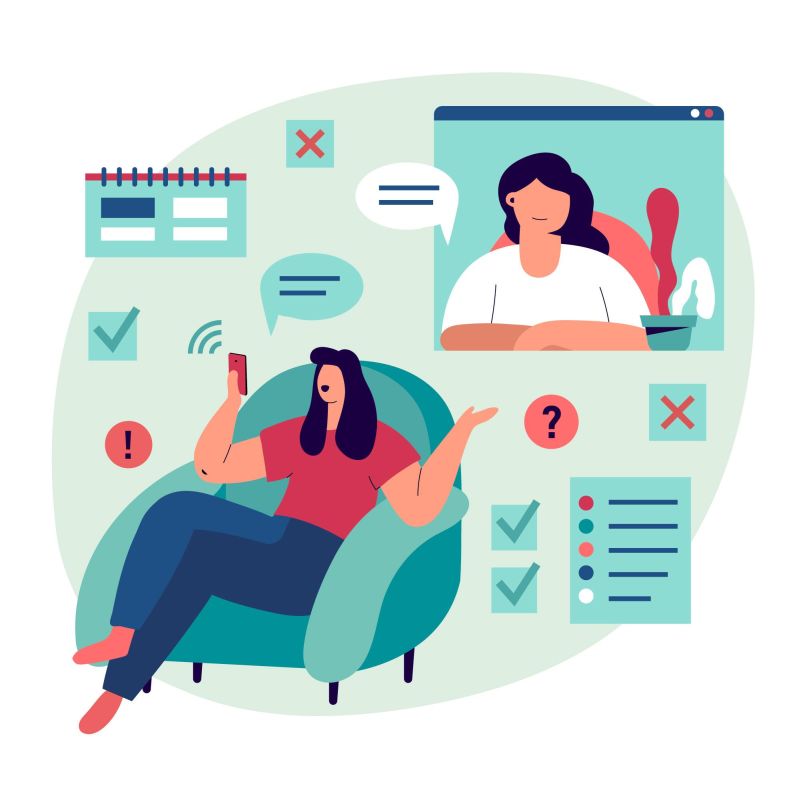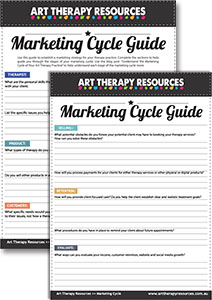THIS POST INCLUDES:
1. Type of Digital Marketing
2. Content Creation and Tools
3. SEO Tools
4. Free Download SEO Checklist
DIGITAL MARKETING IS ESSENTIAL

Digital marketing has become an indispensable aspect of establishing and promoting art therapy practices. As the digital landscape continues to evolve, art therapists must navigate the vast array of tools available to effectively showcase their expertise, engage with potential clients, and build a robust online presence.
A well-designed website is the cornerstone of any digital marketing strategy. It serves as a central hub where potential clients can learn about your services, read about your qualifications, and get a sense of your therapeutic approach. Incorporating elements such as a blog, client testimonials, and informative articles about art therapy can further enhance the website’s value, making it a resource for those interested in learning more about the field.
Search engine optimization (SEO) is another critical component. By optimizing your website and content for search engines, you increase the likelihood that potential clients will find you when searching for art therapy services in your area. This involves using relevant keywords, creating high-quality content, and ensuring your website is user-friendly.
Social media platforms offer a powerful way to connect with a broader audience. Regularly posting engaging content, such as tips for mental wellness, behind-the-scenes looks at your practice, and client success stories (with permission), can help build a community around your practice. Platforms like Instagram, Facebook, Pinterest, and LinkedIn allow for direct interaction with followers, fostering a sense of connection and trust.
Email marketing is another effective tool for staying in touch with current and potential clients. Sending out regular newsletters with updates, articles, and special offers can keep your audience engaged and informed about your practice.
In addition to these tools, online directories and review sites can enhance your online presence.
By strategically utilizing these digital marketing tools, art therapists can not only reach a wider audience but also establish a strong, credible online presence that reflects their expertise and dedication to helping clients through the healing power of art therapy.
Creating engaging content is a fundamental aspect of digital marketing. Art therapists can produce a variety of content types, such as blog posts, videos, and infographics, to educate potential clients about the benefits of art therapy. For instance, blog posts can delve into topics like the therapeutic process, success stories, and the science behind art therapy. Videos can showcase therapy sessions, offer relaxation techniques, or provide art-making tutorials, making the therapy process more relatable and accessible.
Another significant opportunity lies in data-driven marketing. By analyzing website traffic, social media engagement, and email open rates, art therapists can gain insights into their audience’s preferences and behaviors. This information can guide content creation, ensuring that it resonates with the target audience and addresses their needs.
Moreover, digital advertising on platforms like Google Ads and Facebook Ads allows art therapists to reach a broader audience. These platforms offer sophisticated targeting options, enabling therapists to focus on specific demographics, locations, and interests. This targeted approach maximizes the return on investment and ensures that marketing efforts reach those most likely to benefit from art therapy.
CONTENT CREATION AND TOOLS
Digital marketing includes creating visually appealing content. Choosing design tools to create eye-catching graphics, promotional materials, and engaging social media posts is essential. Here’s a guide on how to effectively use these tools to convey your brand identity and attract potential clients.
1. Choose the Right Design Tools:
– Canva: Ideal for beginners and professionals, Canva offers a wide range of templates and design elements. You can create everything from social media posts to brochures.
– Adobe Spark: Another user-friendly tool, Adobe Spark allows you to design stunning graphics, videos, and web pages with ease.
2. Create a Consistent Brand Identity:
– Develop a Color Scheme: Choose colors that represent your practice and use them consistently across all marketing materials.
– Select Fonts: Use fonts that align with your brand’s personality. Maintain consistency by using the same fonts in all your graphics.
– Logo and Imagery: Ensure your logo is present on all visuals. Use high-quality images that reflect the therapeutic nature of your practice.
3. Design Engaging Social Media Posts:
– Templates: Utilize pre-made templates available in Canva and Adobe Spark to maintain a cohesive look.
– Content Variety: Create a mix of content types such as quotes, tips, client testimonials (with consent), and infographics about art therapy benefits.
– Calls to Action: Incorporate clear calls to action in your posts to encourage engagement, such as booking a session, visiting your website, or sharing your content.
4. Develop Promotional Materials:
– Flyers and Brochures: Design informational flyers and brochures that outline your services, philosophy, and contact information. These can be shared both digitally and physically.
– Business Cards: Create professional business cards using these tools to distribute at networking events or to new clients.
– Email Campaigns: Design visually appealing email templates to send newsletters, updates, and promotions to your subscriber list.
5. Enhance Your Website with Visual Content:
– Hero Images and Banners: Use captivating images on your website’s homepage and headers to create an inviting atmosphere.
– Blog Graphics: Accompany blog posts with relevant graphics or infographics to break up text and enhance readability.
– Video Content: Create short videos introducing yourself, explaining your services, or demonstrating art therapy techniques. Tools like Adobe Spark can help in creating and editing videos.
CREATING AND USING DIGITAL MARKETING TOOLS – A SIMPLIFIED APPROACH
1. Plan Your Content Calendar:
– Outline the types of content you want to create and establish a posting schedule. Consistency is key to maintaining engagement.
2. Utilize Templates:
– Use templates provided by Canva or Adobe Spark to streamline the design process. Customize these templates to align with your brand.
3. Incorporate Feedback:
– Gather feedback from peers or clients on your visuals and make adjustments as needed. This ensures your content resonates well with your audience.
4. Optimize for Platforms:
– Tailor your visuals to fit the specifications of different platforms. For example, Instagram posts require square images, while Facebook cover photos have different dimensions.
5. Track Performance:
– Use analytics tools provided by social media platforms to track the performance of your visuals. Identify which types of content perform best and refine your strategy accordingly.
By following these steps and utilizing design tools effectively, art therapists can create compelling visuals and content that enhance their digital marketing efforts. This not only helps in building a strong online presence but also attracts and engages potential clients, ultimately contributing to the growth and success of your art therapy practice.
SEO TOOLS

Search Engine Optimization (SEO) is crucial for improving online visibility, especially for art therapists looking to attract new clients and grow their practice. By leveraging SEO tools, art therapists can conduct comprehensive keyword research, analyze website performance, and implement effective strategies to rank higher in search engine results. Enhanced SEO ensures that potential clients can easily find art therapy services online.
Moz is a powerful SEO tool that offers a suite of features designed to optimize a website’s search engine performance. One of the primary uses of Moz is keyword research. Art therapists can use Moz’s Keyword Explorer to discover the most relevant and high-traffic keywords related to art therapy. By understanding what potential clients are searching for, therapists can tailor their website content to include these keywords, improving the chances of appearing in search results. Additionally, Moz offers a Site Crawl feature that scans your website for any SEO issues, such as broken links or missing meta descriptions, and provides actionable recommendations for improvement.
SEMrush is another robust SEO tool that provides a comprehensive range of services to enhance online visibility. For art therapists, SEMrush can be instrumental in competitive analysis. By analyzing the SEO strategies of other art therapy websites, therapists can identify strengths and weaknesses in their own approach. SEMrush’s Domain Overview tool allows users to see the organic search traffic, keywords, and backlinks of competitor sites. This information is invaluable for developing a more effective SEO strategy. SEMrush also offers an On-Page SEO Checker, which provides insights into how to optimize individual web pages to rank higher on search engines.
To maximize the benefits of SEO tools, art therapists should follow a systematic approach. First, conducting thorough keyword research is essential. Keywords should be relevant to the services offered and reflect what potential clients are searching for. This might include terms like “art therapy for anxiety,” “online art therapy sessions,” or “benefits of art therapy.” Once identified, these keywords should be naturally incorporated into website content, including blog posts, service descriptions, and metadata.
Next, analyzing website performance is crucial. SEO tools can track various metrics, such as page load speed, mobile friendliness, and user engagement. Moz and SEMrush both provide insights into these areas, helping art therapists understand how their website performs from an SEO perspective. By addressing any identified issues, such as slow loading times or poor mobile optimization, therapists can improve their site’s overall performance and user experience, which are critical factors in SEO.
Implementing strategies to build high-quality backlinks is another important aspect of SEO. Backlinks are links from other websites to your own, and they signal to search engines that your site is a credible and authoritative source. SEO tools can help identify opportunities for backlinking, such as guest blogging on relevant sites or partnering with complementary health and wellness businesses. Monitoring backlinks using tools like SEMrush’s Backlink Analytics can ensure that the links are of high quality and contribute positively to your SEO efforts.
Regularly updating and optimizing content is also key to maintaining good SEO. Search engines favor websites that provide fresh, relevant content. Art therapists should aim to publish regular blog posts, case studies, and client testimonials that are optimized with target keywords. Tools like Moz’s Content Optimization feature can help refine content to meet current SEO standards and trends.
Local SEO is another critical area, especially for art therapists who offer in-person sessions. Ensuring that your practice appears in local search results can significantly increase visibility to potential clients in your area. Management tools can help optimize your practice’s online presence for local searches and ensure your business information is accurate across various directories, managing reviews, and optimizing for local keywords.
Finally, measuring the impact of your SEO efforts is essential. By regularly reviewing data, art therapists can see what’s working and what needs adjustment. This ongoing process of evaluation and optimization is crucial for sustained success in search engine rankings. SEO is a vital component of digital marketing for art therapists. Utilizing tools allows for effective keyword research, website performance analysis, competitive analysis, and content optimization. By implementing a well-rounded SEO strategy, art therapists can significantly improve their online visibility, making it easier for potential clients to find and engage with their services.
FREE DOWNLOAD: Art Therapy Exercise
SIGN UP below to gain access to our RESOURCE LIBRARY and download the FREE Marketing Cycle Guide

BUILD YOUR ART THERAPY REFERENCE MATERIALS:
Pin this image to your Pinterest board.

SHARE KNOWLEDGE & PASS IT ON:
If you’ve enjoyed this post, please share it on Facebook, Twitter, Pinterest. Thank you!
